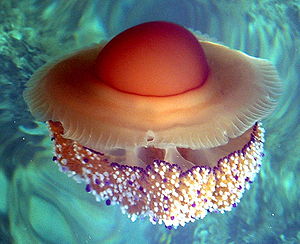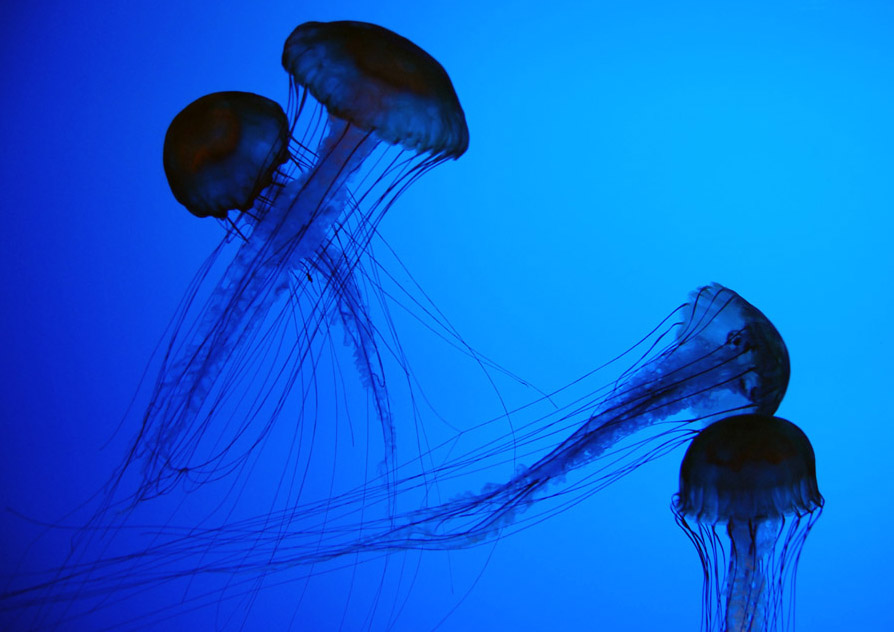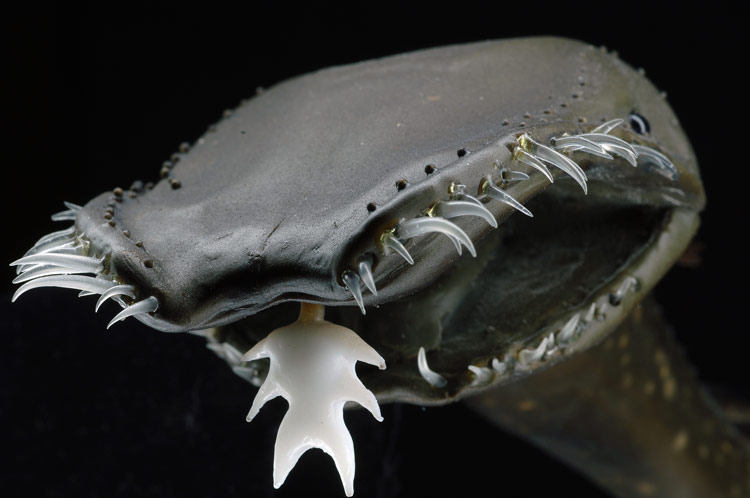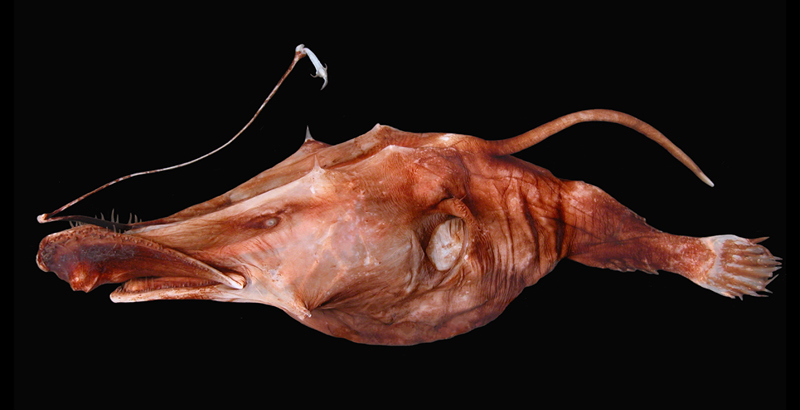Tiefseewesen
09.08.2011 um 03:34




Tiefseewesenheute um 09:53Deshalb dachte ich, du hast Daten über den kleinen Knuddler!
Okay, den hab ich schon einmal gepostet, aber ich finde, der sieht einfach zu gut aus.
Deshalb noch mal
Lasiognathus amphirhamphusHm, all zu viel findet man darüber auch nicht heraus.
Morphology
The body of metamorphosed females of the Genus Thaumatichthys is somewhat longer and more slender than that of most other female ceratioids. The anterior portion of the body just behind the head is depressed, while the posterior portion is cylindrical. The head is broad and highly depressed, its length about 35% SL (measured to the posterior-most margin of the cleithrum). The mouth is large, the cleft extending posteriorly slightly beyond the eye. Sphenotic, quadrate, and articular spines are rudimentary. The pterygiophore of the illicium is unusually short (only 14.3% SL in a 69.9-mm specimen of T. binghami) and completely hidden beneath the skin of the head. The illicial bone is also extremely short (only about 3.2% SL in a 69.9-mm specimen of T. binghami), directed ventrally, and emerging anteriorly from the roof of the mouth (i.e., from the ventral margin of membrane that connects the premaxillae, see below). The escal denticle is deeply embedded and curved and sharply pointed at both ends. The pectoral-fin lobe is small, relatively short and broad, the first (dorsal-most) radial simple and rod-like, without a distal expansion. The second and third pectoral radials are nearly equal in size; their widely expanded distal ends are fused together in a 69.9-mm specimen of T. binghami; the fusion is nearly complete in a 143-mm specimen of T. binghami; the second and third pectoral radials are completely fused to each another in a 294 mm specimen of T. binghami and in the 365-mm holotype of T. axeli. The first epibranchial is bound to the wall of the pharynx. All four epibranchials are closely bound together. The proximal one-half to two-thirds of the first ceratobranchial is bound to the wall of the pharynx, the distal one-half to one-third free. The fourth epibranchial and ceratobranchial are bound to the wall of the pharynx, leaving no opening behind the fourth arch. Gill filaments are absent on the epibranchials, but present on the full length of ceratobranchials II–IV. A pseudobranch is absent. Pyloric caeca are absent. The ventral surface of the head and body is covered with numerous small dermal spinules, increasing in number and size with growth; they are restricted in smaller specimens to the opercular region of the head and ventral surface of the body (except for the caudal peduncle where they reach the dorsal midline), but in the largest known specimens they extend to the ventral surface of the lower jaw, the lateral surfaces of body, and the rays of the anal and caudal fins. The skin is everywhere dark brown to black; the roof of the mouth and extending over lower jaw is brown, while the inner walls of the mouth cavity are nearly or completely unpigmented. Darkly pigmented skin covers the rays of the dorsal, anal, and caudal fins.
The premaxillae of females are strong, well ossified, and widely separated anteriorly, where they are connected only by membrane; they are hinged to the ethmoid region of the cranium in such a way as to allow them to flip dorsally and ventrally, enclosing the lower jaw in the latter position. The ascending process of each premaxilla forms a slightly up-turned spine, lying in front of an extremely long, posterolaterally directed articular process. Each ascending process is connected by an elastic band of tissue to the anterior end of the maxilla and palatine of the opposite side. The maxillae are thin and slender, each with a small nearly undivided head attached by ligaments to the head of the respective palatine. The dentaries are relatively weakly developed, without a symphysial spine; there is a small anterior-maxillomandibular present posteriorly that connects the dentary to the respective premaxilla and maxilla.
The premaxillae of females bear long, slender hooked teeth, arranged in a very distinctive pattern, consisting of six overlapping, oblique longitudinal series: the first tooth of each of six series is spaced along the edge of the jaw in young specimens; the second tooth of each series develops slightly in front of and ventromedial to the first tooth of the following series; the third tooth of each series develops in front of and inside the second tooth of the following series, etc., forming in this way oblique transverse series that cross the longitudinal series. In each series, longitudinal as well as transverse, the teeth increase in length in both posterior and medial directions. The larger teeth of series II–IV are especially well hooked.
The dentary teeth of females are shorter and less curved than those of the premaxillae; they increase in number and size with age, varying from 9–10, the largest measuring 1.2–1.5 mm in the smallest known specimens of T. binghami; 22–30 and 5.6–10.3 mm in the three largest specimens of T. binghami; and 39–40 and 10.5 mm in the holotype of T. axeli. The dentary teeth are arranged in distinct anteromedial series, each of two to four teeth of increasing length, with the smallest positioned outermost. The vomer and palatine are toothless. The second and third pharyngobranchials are well toothed.
The body of metamorphosed males (four known specimens, 15–36 mm, the following description based on the two largest specimens, 31–36 mm) is long and slender. The snout is pointed, with hooked denticles at the tip. There are four or five upper denticles, arranged in two transverse series, a dorsal (outer) series of two or three and a ventral (inner) series of two: those of the dorsal pair are somewhat larger (3.3–4.2% SL) and curved ventrolaterally; those of the ventral pair are more strongly hooked, with their distal ends curved ventrally and their sharp tips thus pointing posteriorly, nearly parallel to their shafts. The premaxillae are toothless, each with a well-developed articular process, without any trace of resorption. The maxillae are similarly well developed, the head of each bearing two processes, a shorter medial process that extends beneath the articular process of the respective premaxilla, and a lateral process that lies close to the outer surface, reaching the base of the upper-most denticles. There are seven lower denticles arranged on the chin in two bilateral, symmetrical series: a ventral (outer) row of four large denticles, with dorsolaterally curved pointed tips; and a dorsal (inner) series of three shorter denticles. The somewhat expanded bases of the seven lower denticles are fused and attached to the anterior tips of the dentaries by connective tissue. The dentaries are toothless, without a trace of tooth sockets.
The opercle and subopercle of the males is similar in shape to those of the females: the dorsal part of the opercle is divided into six or seven slender radiating branches; the dorsal part of the subopercle is slender, tapering to a point, the ventral part truncate, with an anterodorsal spine. The pelvic bones are as described for females. The diameter of the pigmented part of the eye is 1.5–1.6 mm (4.2–5.2% SL); the diameter of the transparent outer coat of the eyeball is 2.0–2.1 mm (5.6–6.8% SL). The olfactory organs are unusually large, the posterior nostril much larger than the anterior nostril, its length 2.6–3.0 mm (7.2–9.7% SL), each with 13 olfactory lamellae. There are 6 dorsal-fin rays, 4 anal-fin rays, 15 pectoral-fin rays, and 9 (2 simple + 4 bifurcated + 3 simple) caudal-fin rays (Table 0). The skin is dark brown, with numerous small spinules scattered over the body from the occipital region to the base of the caudal fin. The head and body are covered with a layer of light dusky subdermal pigment of nearly uniform density. The testes are immature, each about 4.2–6.5 mm in length (11.7–21.0% SL) and 1.1–1.2 mm (3.1–3.9% SL) in width.
The larvae of Thaumatichthys have a layer of subdermal pigment covering the entire surface of the head and body, with concentrations along the margin of the gill-cover, on the peritoneum, and on the dorsal surface of the trunk. The pigment is less concentrated to absent on the pectoral-fin lobe and at the base of the caudal fin. Small scattered melanophores are present in the outer transparent skin. The skin of the largest known larva (22.6 mm) is somewhat more densely pigmented.
Mehr konnte ich zur Morphologie jetzt nicht finden. ;)